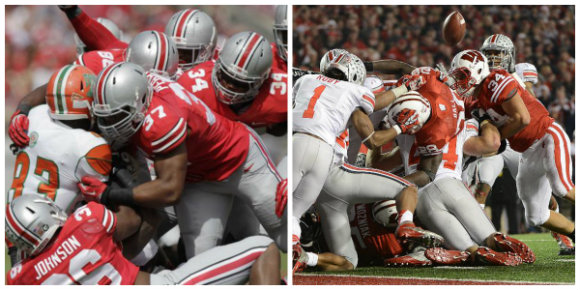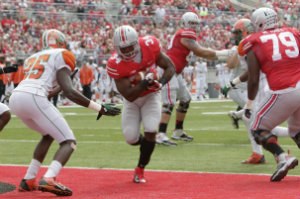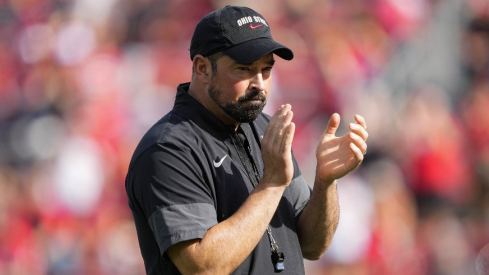
This week has a pretty interesting juxtaposition: the third overall rushing attack in the country and, well, a total of 50 rushing yards in a game. Florida A&M was as bad or worse than expected (and we have the numbers to prove it), while no one is quite sure just how good the king of the conference is right now.
Sure, they beat up on the undisputed worst team in the Big Ten and went toe to toe with perhaps the fifth-best team in the Pac-12. Is that the Big Ten's kind of king?
Of course not. Below I'll preview the Wisconsin game statistically (surprise: the Badgers can run the ball) and break down the charting data from Florida A&M. So let's get on with it.
The Sacrificial Lamb
I'm going to concentrate on the first two quarters of charting data, as the first half was kind of like a spring game. Theoretically, we should get a sense of 1. what the Buckeyes needed to work on offensively and defensively, and 2. what the coaches wanted to make sure was on film for later opponents.
Offensively, it was clear that the Buckeyes wanted some work on their dropback pass game (and it's extremely possible that the gameplan would have been the same if Miller had started). In the first quarter, half of Kenny's 26 passes were three-step drop passes, with a few tunnel screens, rollouts, and playaction passes mixed in. Interestingly, only one of those thirteen passes was to the left side of the field. Kenny certainly favors the right.
The vast majority of these (17) were with the tightend (Heuerman throughout most of the first quarter, then more Vannett in the second) split out wide as a wide receiver. They primarily operated out of the shotgun open trips left, with the tightend split out wide and a presnap movement by the runningback from the pistol and next to the quarterback.
There are many advantages to splitting the tightend out wide, including the matchup between slower linebackers or smaller defensive backs and the Buckeyes' large and quick tight ends, as well as having a fantastic blocker on the edge (along with Evan Spencer) to help outside runners. While inside zone was and will be the staple of the running game, the Buckeyes now have the blocking and personnel needed to effectively threaten with plays like inverted veer, outside zone, and quick screens to get skill players on the edge quickly.
In the process of setting school records on touchdown passes, Kenny had a fairly good day passing the ball:
| Catchable | Bad | Dead On |
|---|---|---|
| 11 | 8 | 15 |
26/34 quality passes is about on pace with his typical performance, as was his accuracy and targeting. I just started keeping track of which said of the field Kenny typically passes to, but I would guess that he typically favors the right side of the field in other games as well. His misses were all on difficult intermediate-to-long throws of 10, 15, 30, 17, and 10 yards.
It was not a day for yards after catch like I expected, with the most significant gainers listed below:
| Vannett | Heuerman | Heuerman | Brown | Wilson | |
|---|---|---|---|---|---|
| Air Yards | 1 | 5 | 5 | 13 | 0 |
| Yards | 12 | 11 | 18 | 18 | 7 |
Despite 34 points in the first quarter, none of them were off of explosive plays. That's what turnovers and field position will do for you. In fact, the three first-half (non-Ezekiel Elliot) explosive plays came on the same play (inside zone read) to three different runningbacks (Hyde, Hall, and Smith). The Buckeyes increasingly went vanilla throughout the game, working with their base 11 personnel and running their base run game.
On to Wisconsin
With multiple threads in our forum and stories on the front page about how legit Wisconsin's run game is, I wanted to see if the numbers offer a definitive answer. Some are saying that Melvin Gordon and James White are the best backfield in the country, but I want to see if there is any hard evidence to support this claim.
As Kyle has already written about, the Badgers aren't the only team capable of running the ball, as this is a matchup of the third- and sixth-best rushing attacks in the country.
 The Buckeyes can run the ball pretty well too.
The Buckeyes can run the ball pretty well too.Below are some numbers on the Wisconsin offense versus the Ohio State defense, courtesy of Football Outsiders (ranking in parentheses).
Ohio State's defensive numbers were definitely buoyed by facing Florida A&M last week, but Wisconsin had UMass and Tennessee Tech to improve its numbers as well. S&P adjusts for opponents, but it is a little early to make definitive statements about strength of schedule with so few data points.
| Succ. rate | Pts/Play | Rush S&P | Pass S&P | Std. Downs | Pass Downs | |
|---|---|---|---|---|---|---|
| Wisconsin O | 52.4% (15) | .77 (5) | 1.4 (3) | 1.2 (38) | 1.4 (9) | 1 (26) |
| Ohio State D | 33.8% (20) | .35 (8) | .59 (13) | .75 (16) | .76 (20) | .58 (10) |
Here is the Wisconsin defense against the Ohio State offense:
| Succ. Rate | Pts/Play | Rush S&P | Pass S&P | STD. Downs | Pass Downs | |
|---|---|---|---|---|---|---|
| Wisconsin D | 37.6% (38) | .37 (16) | .66 (22) | .8 (27) | .84 (30) | .58 (8) |
| Ohio State O | 54.6% (11) | .72 (14) | 1.2 (7) | 1.3 (19) | 1.2 (15) | 1.4 (5) |
The offenses have the edge in nearly every matchup, except in the matchup between the Wisconsin passing attack and the Ohio State pass defense, where Ohio State holds the edge. It's also important to note that the average difference between units is greater for the Ohio State offense vs. Wisconsin defense than it is for the Wisconsin offense vs. the OSU defense. In short, there should be plenty of points according to these basic numbers.
However, those raw numbers ignore what style of offensive both teams played against. Ohio State has yet to play a rushing powerhouse, but Cal was the only offense that has put up more than two touchdowns against the Buckeyes this season. That Cal offense featured the short pass and quick screen horizontal pass game and close to 100 plays. Wisconsin does not have that kind of offense.
Regardless, Wisconsin's run game is formidable. Any team that averages 7.99 yards per carry is dangerous on the ground – but that's kind of normal for Wisconsin, right? Well, almost eight yards per carry is above what their offense normally produces (averaging nearly 5.5 YPC for the last four years), but there is still time to regress to the mean. The Buckeyes intend to make that happen on Saturday.

